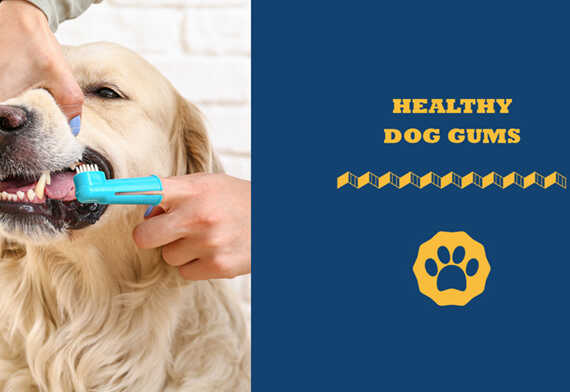Updated: October 14th, 2022
This article contains affiliate links. Read the full disclosure here.
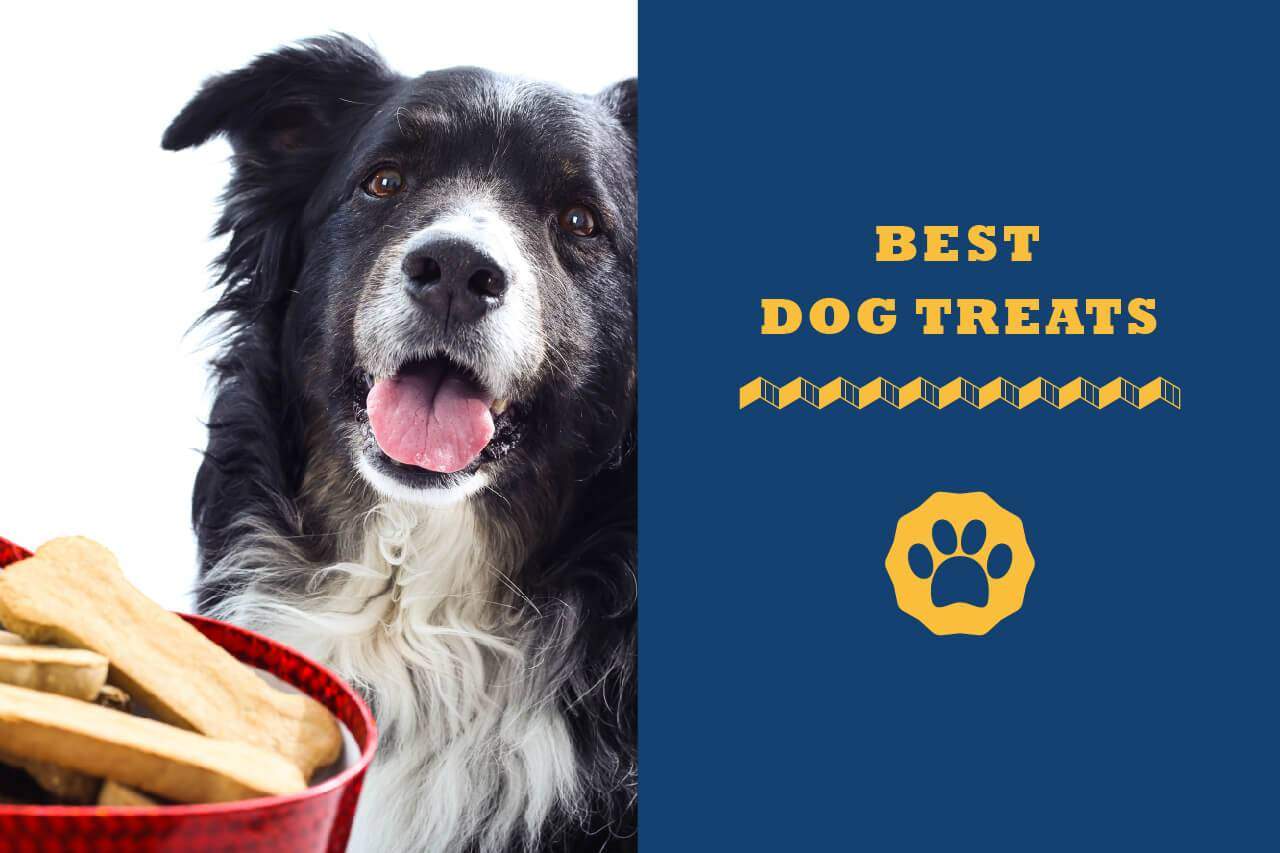
The best dog treats are an essential tool when it comes to training your pooch, reinforcing good behavior, or simply making them feel loved and appreciated. But just as treats in a human diet can cause major health issues if nutritional value and calorie content aren’t considered, the same is true for dogs. Treats are notoriously high in calories, and just a few treats can push them well over their daily calorie needs.
-
-
Rocco & Roxie Supply Co. Gourmet Beef Jerky Sticks – Best Overall
-
Wellness Soft Puppy Bites Grain-Free Lamb & Salmon Recipe Dog Treats – BEST PUPPY TREAT
-
Old Mother Hubbard Classic Original Assortment Biscuit Baked Dog Treats – Best Budget
-
American Journey Peanut Butter Recipe Grain-Free Oven Baked Crunchy Biscuit Dog Treats – BEST LOW-CALORIE TREATS
-
Blue Buffalo Wilderness Trail Treats Duck Biscuits Grain-Free Dog Treats –BEST HYPOALLERGENIC TREATS
-
SmartBones SmartSticks PeanutButter Chews Dog Treats – BEST FOR SENSITIVE STOMACHS
-
Greenies Regular Dental Dog Treats –BEST DENTAL TREATS
-
An Overview of Top 7 Dog Treats
| IMAGE | PRODUCT | |
|---|---|---|
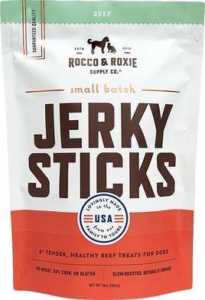 |
| VIEW LATEST PRICE → |
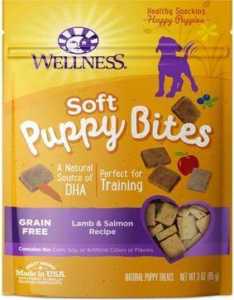 |
| VIEW LATEST PRICE → |
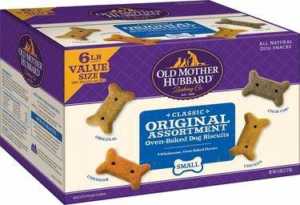 |
| VIEW LATEST PRICE → |
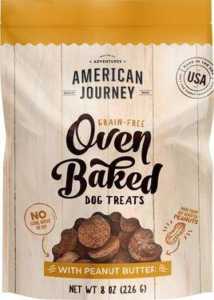 | BEST LOW-CALORIE TREATS
| VIEW LATEST PRICE → |
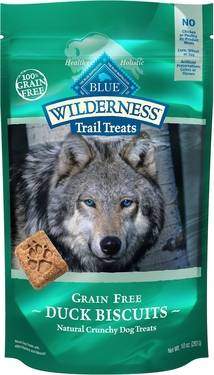 | BEST HYPOALLERGENIC TREATS
| VIEW LATEST PRICE → |
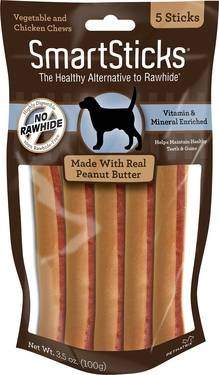 | BEST FOR SENSITIVE STOMACHS
| VIEW LATEST PRICE → |
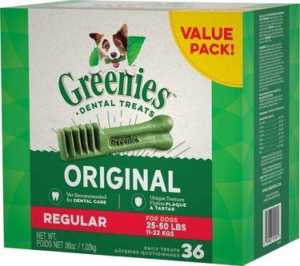 | BEST DENTAL TREATS
| VIEW LATEST PRICE → |
When it comes to dog treats, it is important to pick the right thing to reward your pup. This depends on their personal preferences, life stage, and what you are trying to achieve with the treat. It is also important to look for treats with the right nutritional content and caloric value in order to complement your dog’s regular diet rather than push them off course.
Read on to learn more about seven of the best dog treats currently available and which dogs they’re best for. I have also shared a comprehensive buying guide to give you all the information you need when looking for the ideal treat for your dog.
Top 7 Dog Treats
1. Rocco & Roxie Supply Co. Gourmet Beef Jerky Sticks – Best Overall Treat

This is a bag of six-inch turkey jerky sticks made from naturally smoked beef—though they also come in chicken and turkey flavors.
Nutritional Information
- Crude protein 20% minimum
- Crude fat 4% minimum
- Crude fiber 2% maximum
- Moisture 25% maximum
- 20 calories per stick
Meat is the first ingredient in this recipe, so it will appeal to your dog’s instinctive need for quality meat-based protein and give them the nutrients that they need rather than just empty calories.
These treats also won’t break the calorie bank at only 20 calories per stick, and they can easily be broken into smaller pieces as training rewards. Nothing artificial is added to worry about, though the recipe is relatively high in salt and sugar.
Rocco & Roxie also use a unique manufacturing process that ensures that the treats won’t leave any smelly, oily residue on your hands when you feed your pooch.
Pros:
- Meat as the first ingredient
- All natural
- Low in calories
- Multiple flavors
- No artificial ingredients
- No greasy residue
Cons:
- Relatively high in salt and sugar
If you want to treat your dog with something delicious and meaty that is all natural and approximates what they would eat in the wild, then these jerky sticks are an excellent choice.
2. Wellness Soft Puppy Bites Grain-Free Lamb & Salmon Recipe Dog Treats – Best Puppy Treat

If you are training your new puppy and worry about excessive calories and potential allergens, then these soft bites from Wellness will tick a lot of boxes.
Nutritional Information
- Crude protein 15% minimum
- Crude fat 12% minimum
- Crude fiber 2% maximum
- Moisture 30% maximum
- 3,200 calories per kilogram
Specially formulated for puppies under one year old, these meat-based treats combine novel proteins to help avoid common allergens. The salmon in this recipe is also great for the development of your puppy’s nervous system and eyes, as it is rich in docosahexaenoic acid (DHA). It is also high in anti-inflammatory ingredients and antioxidants for a better immune system and a shinier coat.
The recipe is free from grains, which can be a common allergen, and has nothing artificial added to mess with your puppy’s system. The treats come in small sizes, ideal for smaller dogs, so there is no need to break them up. Each treat is already relatively high in calories and fat, but this should be no problem for rapidly growing pooches.
Pros:
- Specially formulated for puppies under one year
- Nutrients for growing puppies
- Meat as the first ingredient
- Affordable
Cons:
- Relatively high in fat
- Relatively high in calories
When it comes to puppy training, Wellness offers one of the best treats on the market for growing dogs.
3. Old Mother Hubbard Classic Original Assortment Biscuit Baked Dog Treats – Best Budget Treat

This company has been producing dog food and dog treats for over 90 years, so they know what they are doing!
Nutritional Information
- Crude protein 12% minimum
- Crude fat 7% minimum
- Crude fiber 5.5% maximum
- Moisture 11% maximum
- 33 calories per piece
These highly affordable baked biscuit treats come in a variety of sizes and flavors, so you can get the right size treat for your dog. There’s a flavor for even fussy pooches.
The Classic P-Nuttier is probably their most popular and mixes creamy peanut butter with carrots, apples, and molasses. Their bacon-and-cheese line is also very popular. While these might all sound pretty indulgent, the resulting treat is low-calorie at an average of only 33 calories per piece.
The treats are made with all-natural ingredients and baked to preserve flavors while giving a crunchy texture that is great for dogs’ teeth. I would like to see the recipes contain more meat, but they are mostly wheat and oatmeal based with meats added only for flavor.
Pros:
- Affordable
- Variety of sizes and flavors
- Low in calories
- No artificial ingredients
- Good for teeth and gums
Cons:
- Could contain more meat
If you are looking for something highly affordable that your dog will love then consider Old Mother Hubbard.
4. American Journey Peanut Butter Recipe Grain-Free Oven Baked Crunchy Biscuit Dog Treats – Best Low-Calorie Treats

If your dog needs some serious training incentives, but you are worried about excessive calories, try these low-calorie treats from American Journey.
Nutritional Information
- Crude protein 16% minimum
- Crude fat 9% minimum
- Crude fiber 6% maximum
- Moisture 12% maximum
- 13 calories per chew
While these bites are very small and low-calorie, at only 13 calories per treat, they are full of flavor, so your dog won’t feel like they are missing out on anything. The recipe combines real peanut butter with chickpeas, peas, and chicken fat to create a tasty baked treat. There is nothing artificial added, and the recipe is also grain-free and doesn’t use any meat by-products, so it does not contain anything that should upset your dog’s stomach.
I personally like to see a bit more meat in my dog treats, but I would definitely use these when training something new and worried about overfeeding my dog.
Pros:
- Low in calories
- Grain free
- No artificial ingredients
Cons:
- Could contain more meat
5. Blue Buffalo Wilderness Trail Treats Duck Biscuits Grain-Free Dog Treats – Best Hypoallergenic Treats
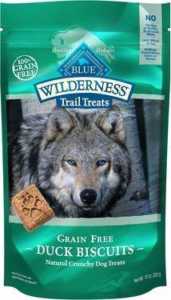
If you are worried about potential protein allergies with treats, then these novel protein biscuits from Blue Buffalo will put your mind at ease.
Nutritional Information
- Crude protein 30% minimum
- Crude fat 15% minimum
- Crude fiber 3.5% maximum
- Moisture 11% maximum
- 41 calories per biscuit
Blue Buffalo always start their recipe with a novel protein, avoiding common allergen meats such as chicken, lamb, and beef. Instead you will see duck, alligator, salmon, and venison. The recipe also avoids other common allergens such as grains and gluten.
The chosen, all-natural ingredients are baked into a crunchy treat that is enriched with omega-3 and omega-6 fatty acids for optimal health. The result is a treat that is high-protein but also high-fat. This means that when it comes to training, the high-calorie biscuit should probably be broken up, but they aren’t designed to easily separate. This makes them a better treat for larger dogs.
Pros:
- All natural
- Meat as the first ingredient
- Novel proteins
- High in protein
- Grain and gluten free
Cons:
- Relatively high in fat
- Relatively high in calories
If you are looking for a way to treat your dog that won’t flare up their allergies, then try Blue Buffalo’s Wilderness Trail Treats.
6. SmartBones SmartSticks PeanutButter Chews Dog Treats – Best Treats For Sensitive Stomachs
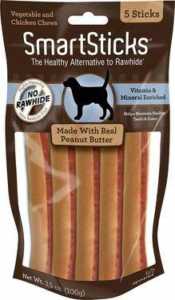
If you’re looking for a treat for a dog with a sensitive stomach, then try these SmartSticks from SmartBones.
Nutritional Information
- Crude protein 9% minimum
- Crude fat 0.2% minimum
- Crude fiber 1.5% maximum
- Moisture 14% maximum
- 55 calories per chew
This dog treat is marketed as being made with real chicken and vegetables, but—while it does have chicken and veg that are great for your pup—it actually contains corn before chicken and fructose before any vegetable. So, while this is still an excellent treat, it is not as good as advertised.
This treat from SmartBones makes it onto the list because they are highly digestible which makes them ideal as a way for giving some love and affection to pooches with sensitive stomachs…without having to worry about them feeling unwell later.
These treats are also very chewable which will satisfy dogs that love to chew, and it will be great for their dental health. While they are low in fat, they are also high in calories so feed in moderation.
Pros:
- Good for dental health
- Highly digestible
- Low in fat
Cons:
- High in calories
- Corn as first ingredient
Treating dogs with sensitive stomachs can be challenging. Make it easy with these smart treats.
7. Greenies Regular Dental Dog Treats – Best Dental Treats

If your dog suffers with bad breath, treat them and work on their dental problems at the same time with these green treats.
Nutritional Information
- Crude protein 30% minimum
- Crude fat 5.5% minimum
- Crude fiber 6% maximum
- Moisture 15% maximum
- 91 calories per treat
These all-natural treats are specially designed to reduce plaque and tartar while your dog chews. They also leave a fresh breath aftertaste and come in a variety of sizes so that you can find the right one for your dog.
These treats are high in calories and don’t offer that much nutritional benefit for your dog, containing almost no protein. So, this is a treat that should be used specifically to deal with dental issues rather than as a regular treat or for training.
Pros:
- Great for dental health
- All natural
- Variety of sizes
Cons:
- High in calories
- Low in protein
Does your dog have smelly breath? Show them you still love them with these dental treats that will help fix their breath and dental problems too.
Dog Treat Buying Guide
When it comes to picking dog treats, first and foremost you need to find something that your pooch loves, as it is meant to be a treat after all. This can take a bit of trial and error, but knowing whether they are meat lovers, cheese fiends, or peanut butter addicts gives you a good place to start.
Also consider what you are going to use the treats for. If you will be using the treats for training, you will probably need to use a relatively large number of them so will need something low calorie.
If you are just looking for something to give your dog some affection, then this is a less serious concern. Maybe you are looking for a treat to deal with a specific issue, such as bad breath. All of these kinds of things will influence what kind of treats you should buy.
Things To Consider
Once you have an idea of treat you are looking for, then there are a few things to consider.
Calories And Size
In the United States today, around 25 to 30 percent of dogs are obese, and almost 50 percent are overweight. One of the main causes for this is loving parents overfeeding their pets out of love. One of the easiest ways to inadvertently overfeed your dog is with treats which may look small but can contain a lot of excessive calories.
Always check the calorie content of treats, and feed them to your pup appropriately. If you know you will need a lot of treats to train them to do something new, choose something low calorie. Remember that treats should form no more than ten percent of your dog’s daily diet.
Size can play a big role here since, unsurprisingly, the larger the treat, the higher the calories. Generally larger dogs enjoy larger treats, and since they eat more, they can afford to have a few more calories. Smaller dogs and puppies will need smaller treats.
Nutritional Profile
As treats can form a not-insignificant part of a dog’s diet, it is important that they have the right nutritional balance that dogs need. Some things to consider:
Carbohydrates
Unlike cats, which are consummate carnivores and don’t really need carbohydrates in their diets, dogs are omnivores and can get much of the energy that they need from carbohydrates. This means that you can reasonably give your dog a treat that is up to 70 percent carbohydrates without worrying, but something around the 50 percent mark or lower is better.
Protein
Despite being able to indulge in carbohydrates pretty harmlessly, the primary thing that dogs need in their diet is protein which is where they get most of the amino acids that they need to create strong muscle and repair damaged tissue. Meat-based protein is best, from animal meat and eggs, though they can also use other sources of protein such as soybeans. Protein should form at least 18 to 25 percent of their diet.
Fat
While we have been trained to think of fat as unhealthy, dogs need a certain level of fatty acids in their diet to thrive and to give their food the natural flavor that they crave. It also helps maintain a healthy and shiny coat. About 10 to 15 percent of fat is good to see in a dog’s diet.
When it comes to treats you might be looking at a little less, around 5 to 10 percent, as they should be getting most of the fat that they need from their regular meals.
Fiber
Dogs also need a sufficient amount of fiber in their diets to ensure that they are digesting and making use of the nutrients that they are receiving. Around two to four percent fiber is realistic for most dog foods including dog treats.
Allergens
Most of us dog parents are careful to avoid foods that may cause our dogs allergic issues or simply mess with more sensitive stomachs. According to holistic vet, Suan Wynn:
Ten percent of all allergy cases in dogs are food allergies. Dogs can also suffer from food intolerance which is different from a food allergy… The most common allergens are beef, dairy, wheat, egg, chicken, lamb, soy, pork, rabbit, and fish. And most dogs are usually allergic to more than one thing.
Just because dog treats are small, does not mean that we should not be giving their potential allergenic content the same consideration. When looking at dog treats, think about avoiding grains and gluten which are common allergens in dogs.
Also try and look for treats that make use of novel proteins rather than chicken and beef. Your dog is probably already getting a lot of chicken and beef in their normal diet, and these are the meats that they are most likely to develop an allergy to if eaten in excess.
Texture
While full-grown dogs often like a crunchy texture, puppies with jaws that are still developing and older dogs with dental issues won’t necessarily enjoy them in the same way. Some dogs also like a chewy treat that will last rather than break down and be swallowed in a matter of seconds.
It is important to consider whether your dog needs something that is easy to eat, likes the crunch, or wants to chew.
How To Treat Your Dog
How exactly you should treat your dog depends on what you are trying to achieve with them.
If you are just trying to show them love and affection, give them a treat when you wish though only when they have been showing good behavior throughout the day. Be careful not to give them treats shortly after any behavioral mishaps, as this may work to reinforce the negative behavior.
If you are using treats as part of a health regime, such as with dental problems, consider giving them the treat at a regular time each day such as midmorning.
If you are training your dog, for example to use the potty or to use their leash properly, the treats should be used as positive reinforcement. According to The Humane Society of the United States:
Positive reinforcement training uses praise and/or treats to reward your dog for doing something you want them to do. Because the reward makes them more likely to repeat the behavior, positive reinforcement is one of the most powerful tools for shaping or changing your dog’s behavior.
However, it is important to ensure that treats are used to reward behavior rather than as a bribe or a lure. This means that you should not hold the treat in front of them while you are manipulating them or commanding them to complete a certain action. The treat should only be introduced as a reward after the action has been successfully completed.
Treat-based positive reinforcement should also be coupled with praise and affection, so you can more easily transition off using treats once your dog has become more familiar with the required behavior.
Get more tips on how to train your dog using treats with his video from Zak George’s Dog Training Revolution:
FAQs
Are treats bad for dogs?
Treats aren’t bad for dogs, if you find quality treats that are full of the good nutrition that dogs need. The main problem with treating is when they eat too many, as this can lead to weight gain. It can also cause them to expect treats as part of their regular diet which makes them more difficult to use as an incentive for certain behaviors.
Is it bad to give your dog treats every day?
While it is no problem to treat your dog every day, especially if you are training them to do something new, treats should never form more than ten percent of their daily calorie intake. To avoid over treating, limit treats to one or two per day as much as possible.
Should I use treats to train my dog?
Treats can be used as a reward in positive reinforcement training when your dog does something that you want them to do. The reward makes them more likely to repeat the behavior which will become habitual over time without the need for treats.
When should I give my dog a treat?
Use treats to reinforce a calm, submissive state of compliance, and never give dogs treats when they are excited or over-stimulated. Never hold the treat up too high, as this reinforced jumping behavior. Bring the treat close to your dog’s face and hold it just underneath their mouth. There is no need to wave it under their nose, they can smell it.
The Verdict
What dog treat is going to be best for your dog depends on them as an individual and your priorities when it comes to giving your dog treats.
If you are looking for a meaty treat that your dog will love and that will add will complement their regular diet, then the Beef Jerky Sticks from Rocco and Roxie are probably the best thing on the market.
When dealing with puppies and their specific needs, look at Wellness’ puppy treats. When you know you will be doing a lot of training and so want something low calorie but tasty, American Journey’s treats are an excellent choice. And if your dog suffers with allergies, then Blue Buffalo Wilderness treats offer them the best protection.
Whatever treats you choose to give your dogs, remember to give them in moderation to maintain their diet and to ensure that you are reinforcing positive behavior and not simply making treats expected.



